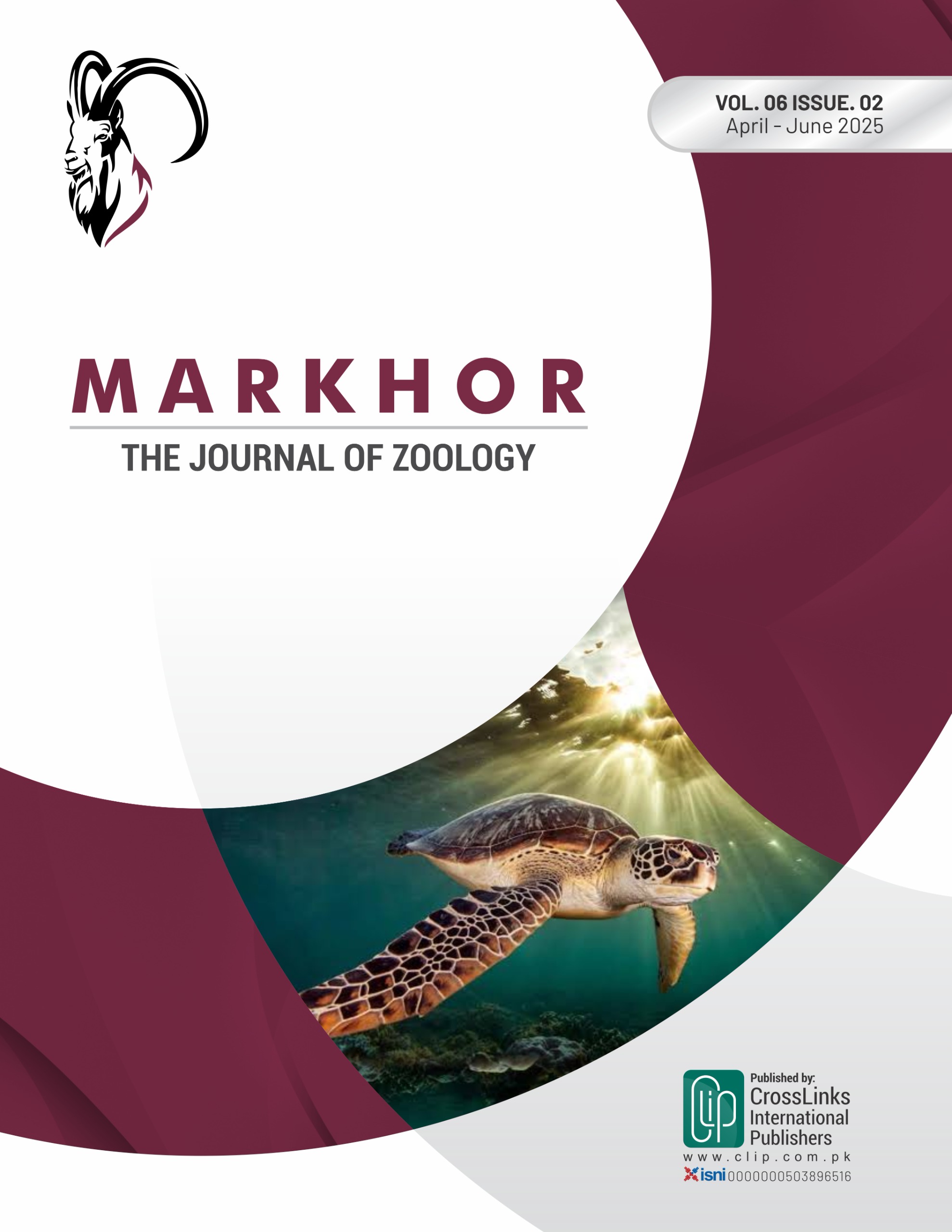Diversity of Insect Pollinators Visiting Rohi Sarson (Brassica Juncea L.) in Southern Punjab, Pakistan
Diversity of Insect Pollinators in Southern Punjab, Pakistan
DOI:
https://doi.org/10.54393/mjz.v6i2.170Keywords:
Rohi Sarson, Insect Pollinators, Pollination, Hymenoptera, Sustainable Agriculture, Floral VisitorsAbstract
Rapeseed is an important oilseed crop in Pakistan, and its yield can be significantly improved through insect pollination. Objective: To explore the diversity of insect pollinators visiting the rapeseed crop (locally known as Rohi Sarson, Brassica juncea) in Panjgrain, District Bhakkar, Southern Punjab, Pakistan. Methods: This Descriptive ecological survey was conducted in Panjgrain, District Bhakkar, Southern Punjab, Pakistan. The crop was grown in October 2024 and flowered from February to April 2025, which coincided with the period of pollinator activity. During this time, data were collected using a cone-type hand net at regular intervals from 10:00 AM to 4:00 PM, when insect activity was at its peak. Captured specimens were preserved and later identified using standard taxonomic methods and online identification tools. Results: A total of 18 insect species were recorded visiting the rapeseed flowers. These species were represented by four major insect classes, namely: Hymenoptera, Diptera, Lepidoptera, and Coleoptera. The best group was Hymenoptera, which comprised different species of honeybee and carpenter bee, mining bee, and paper wasp. It was also found that the dominant pollinators were the honeybees, which defined the production level and quality of the crop. Insects, such as hover flies, butterflies, and beetles, also contributed complementarily to pollination. The pollinators were affected by environmental factors, including temperature, sunlight, and time of day. Conclusions: The study concluded the significant role of insect pollinators in rapeseed production and indicated that sustainability in pollinator diversity on the farm enhances crop output with the help of pollinator-friendly farming systems.
References
Mohamed IA, Shalby N, El-Badri AM, Awad-Allah EF, Batool M, Saleem MH et al. Multipurpose uses of rapeseed (Brassica napus L.) crop (food, feed, industrial, medicinal, and environmental conservation uses) and improvement strategies in China. Journal of Agriculture and Food Research. 2025; 101794. doi: 10.1016/j.jafr.2025.101794.
Eskin MN, Iassonova DR, Rempel CB. High-oleic canola oil. In: High Oleic Oils. AOCS Press. 2022; 89–108. doi: 10.1016/B978-0-12-822912-5.00001-0.
Zada H. Yield and yield attributes of rapeseed cultivars as influenced by sulfur level under Swat Valley conditions. Pure and Applied Biology. 2015.
Abrol DP. Insect pollination and crop production in Jammu and Kashmir. Current Science. 1993; 65: 265–9.
Khalifa SA, Elshafiey EH, Shetaia AA, El-Wahed AA, Algethami AF, Musharraf SG et al. Overview of bee pollination and its economic value for crop production. Insects. 2021; 12(8): 688. doi: 10.3390/insects12080688.
Srivastava KS, Sharma DS, Singh SS, Ahmad HA. Foraging behaviour of honeybees in seed production of Brassica oleracea var. italica Plenck. 2017.
Fikadu Z. The contribution of managed honey bees to crop pollination, food security, and economic stability: Case of Ethiopia. The Open Agriculture Journal. 2019; 13(1). doi: 10.2174/1874331501913010175.
Bommarco R, Marini L, Vaissière BE. Insect pollination enhances seed yield, quality, and market value in oilseed rape. Oecologia. 2012; 169(4): 1025–32. doi: 10.1007/s00442-012-2271-6.
Stanley DA, Gunning D, Stout JC. Pollinators and pollination of oilseed rape crops (Brassica napus L.) in Ireland: ecological and economic incentives for pollinator conservation. Journal of Insect Conservation. 2013; 17(6): 1181–9. doi: 10.1007/s10841-013-9599-z.
Haldhar SM, Kumar R, Samadia DK, Singh B, Singh H. Role of insect pollinators and pollinizers in arid and semi-arid horticultural crops. Journal of Agriculture and Ecology. 2018; 5: 1–25. doi: 10.53911/JAE.2018.5101.
Hung KL, Kingston JM, Albrecht M, Holway DA, Kohn JR. The worldwide importance of honey bees as pollinators in natural habitats. Proceedings of the Royal Society B: Biological Sciences. 2018; 285(1870): 20172140. doi: 10.1098/rspb.2017.2140.
Shakeel M, Ali H, Ahmad S, Said F, Khan KA, Bashir MA et al. Insect pollinators' diversity and abundance in Eruca sativa Mill. (Arugula) and Brassica rapa L. (Field mustard) crops. Saudi Journal of Biological Sciences. 2019; 26(7): 1704–9. doi: 10.1016/j.sjbs.2018.08.012.
Yadav S, Yadav SS, Jat MK, Kumar H. Diversity and abundance of insect visitors/pollinators on different genotypes of Brassica spp. Journal of Agriculture and Ecology. 2022; 13: 112–20. doi: 10.53911/JAE.2022.13111.
Badenes-Perez FR. Benefits of insect pollination in Brassicaceae: A meta-analysis of self-compatible and self-incompatible crop species. Agriculture. 2022; 12: 446. doi: 10.3390/agriculture12040446
Gomez JM, Navarro L, Gonzalez-Megias A, Armas C, Perfectti F, Caravantes A et al. Pollination effectiveness affects the level of generalisation of a plant species with phenotypically plastic flowers. Annals of Botany Plant. 2025; 17: plae065. doi: 10.1093/aobpla/plae065
Klecka J, Hadrava J, Biella P, Akter A. Flower visitation by hoverflies (Diptera: Syrphidae) in a temperate plant-pollinator network. PeerJ. 2018; 6: e6025. doi: 10.7717/peerj.6025
Jauker F and Wolters V. Hover flies are efficient pollinators of oilseed rape. Oecologia. 2008; 156: 819–23. doi: 10.1007/s00442-008-1034-x
Bansal A and Abrol DP. Diversity and abundance of insect pollinators affecting seed production in Mustard (Brassica napus L.). Journal of Apiculture. 2023; 38: 315–23. doi: 10.17519/apiculture.2023.38.4.315
Goswami VI and Khan MS. Impact of honey bee pollination on pod set of mustard (Brassica juncea L.: Cruciferae) at Pantnagar. The Bioscan. 2014; 9: 75–8.
Yadav R, Kaushal BR, Singh D, Kumar N. Diversity and abundance of pollinating insects in mustard crops of Northern India. Pollination Research. 2022; 12(1): 33–40.
Stanley J, Sah K, Subbanna AR. How efficient is the Asian honey bee, Apis cerana, in pollinating mustard, Brassica campestris var. toria? Pollination behavior, pollinator efficiency, pollinator requirements and impact of pollination. Journal of Apicultural Research. 2017; 56: 439–51. doi: 10.1080/00218839.2017.1329796.
Downloads
Published
How to Cite
Issue
Section
License
Copyright (c) 2025 MARKHOR (The Journal of Zoology)

This work is licensed under a Creative Commons Attribution 4.0 International License.
This is an open-access journal and all the published articles / items are distributed under the terms of the Creative Commons Attribution License, which permits unrestricted use, distribution, and reproduction in any medium, provided the original author and source are credited. For comments editor@markhorjournal.com











